Diego Rao '22 - Introduction
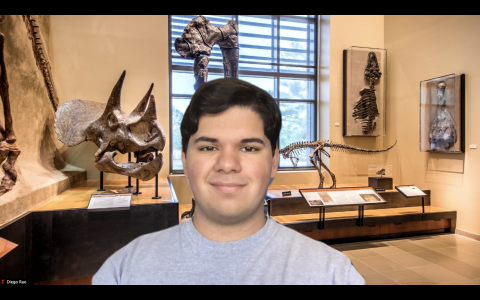

The liberal arts’ reputation has taken a beating in the age of STEM, and as a computer science major, I’ve seen a fair bit of this disparagement firsthand. The usual perception of a liberal arts student these days is of something like “a sociology major who’s going to end up working at McDonald’s.”
But (no shade to my soch majors or my McDonald’s workers) the liberal arts education at Amherst is about so much more. The liberal arts is about exploration and discovery. It’s about learning all the different perspectives that people with different identities and backgrounds and opinions can bring to the exact same question or idea.
Let’s face it: in this world that moves as fast as it does, no amount of class time or homework or office hours will ever teach you every single thing you need to know to succeed in your field, whatever it may be. So the liberal arts is not about learning specific facts, but rather about learning on a fundamental level how to learn, how to integrate all the new information that will inevitably come your way into your existing body of knowledge and how to move forward in ways equally creative and rigorous.
Amherst approaches this mission in a number of ways; one is by promoting interdisciplinary scholarship at every level. Interdisciplinary majors like Environmental Studies or Law, Jurisprudence, and Social Thought pull from a wide range of fields like political science, economics, history, biology, and more. Faculty often collaborate with students and other faculty across different departments as well as within their own; for example, the Ginsburg Fellows program that pairs computer science students with faculty across the college who want to incorporate computational thinking into their work. And many classroom spaces are shared without regard to particular disciplines; the Science Center, though you’d never guess from its name, actually reserves about 20% of its classroom spaces for non-science courses – between myself and my friends, I can think of history, language, American studies, and economics courses that take place right next to chemistry and physics classes. The college also offers courses designated as “science for non-science majors” and “art for non-art majors” which, though open to students who are majors in those fields, are also designed to welcome those with no academic experience in the area. Having classmates with extraordinarily diverse academic interests, not to mention personal backgrounds, makes for a much more enriching, rewarding, and – dare I say – fun academic experience than if you only interacted with people who already see the world similarly to yourself.
One of the most unique – and impossible to fake – aspects of the liberal arts is the culture it creates in the community beyond the classroom. I’ve already written about learning beyond the classroom in the sense of research. But what I’m talking about here is even more abstract – so much so that it took me two years to notice – yet even more profound. So much learning at Amherst takes place through natural conversations with friends and peers, often about seemingly-mundane topics: everything from the latest political occurrences to why the rugby league made a decision it did. These conversations are inconspicuous on the surface, but in the context of a community like Amherst that draws not only bright but extraordinarily curious individuals, they become deep exercises in critical thinking, multifaceted analysis, and energetic exchange. Like so many of the best parts of Amherst, these engagements are hard to notice, impossible to fabricate, and invaluable to experience.
This ubiquitous and multifaceted learning – that happens in every class and every department – makes you a much more dynamic, much more powerful thinker than you would be even if you memorized every single fact that already exists in a given field. It allows you, for example, to take lessons from history and computer science courses and apply them to research in economics. It allows you to take full advantage of the open curriculum, because even if you never take another theater course in your life, you’ll still have learned valuable lessons for whatever you pursue next. It prepares you to take any major and apply it to any industry after college, with confidence in the knowledge that no matter what comes your way, even if your industry is turned completely on its head or you decide to switch to a completely new one, you’ll be able to handle it.
And that is what the liberal arts can do for you.
August 4, 2020
I’ve been missing Amherst a little extra the past few days.
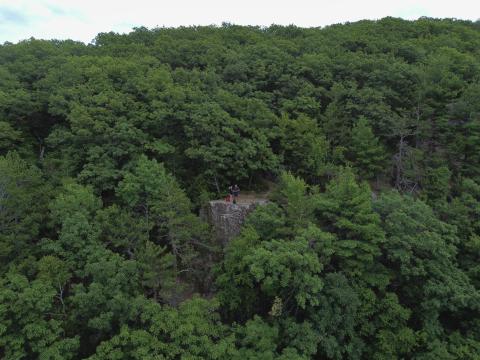
I had the chance to drive out to Amherst this past weekend to pick up the things I had left on campus from when we had to leave on short notice in the spring. I had been excited in the few days leading up to the trip, but I was still astonished by the sheer joy I got from being back in the area, if only for a few hours. I drove through campus to grab my stuff and drop off some books at Frost Library that I had taken with me for a research paper; I grabbed some food in town (it was hard to pick only one of my favorite spots to eat at); and I hiked Mount Tom in Holyoke, a couple towns over from Amherst itself.
Then, yesterday, I went on a socially-distanced walk with a friend of mine from Amherst for a couple hours, and we talked a lot about the college, among other things. We talked about our favorite spots on campus, our favorite classes and professors and friends, the things we miss about life before the pandemic and things about the current situation that may turn out as hidden blessings.
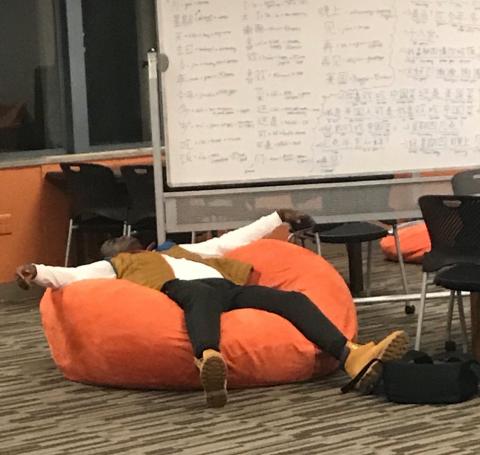
So I’ve had a little more reason than usual to reflect on my time at Amherst so far, and what I might do with the time I have left.
It’s hard to pick one or even just a handful of things I think are most important. There are a lot of obvious ones: my friends, my sport, and, yes, even my classes. But I think a big part of what makes Amherst such a wonderful place is that the small things are just as meaningful and rewarding and fun as the big ones.
The fresh air to start my day on my walk to Val in the morning. Seeing a friend and saying hi, or even just giving a nod or a wave as we pass by each other between classes. The lights in the Science Center turning blue for a few moments on the hour at night, sometimes reminding you that time is ticking and you really have to grind on this assignment, other times reminding you that time is ticking and maybe it’s okay to skip the last few homework problems and get a little extra sleep tonight.

When you look at colleges, online or in person, they’ll show you the big stuff. They’ll show you what classes are like, what clubs you can be in, what it’s like to live in a dorm. These things are obviously important; they’ll take up most of your time and energy and give you the most in return as well. But more than that goes into feeling that a place is just simply right for you. Call it a vibe, a sense, or a gut instinct, I think it’s this infinite multitude of details that we so often overlook that can make the difference between “a college” and “my college.”
It was hard for me to do when I was looking at colleges, and still often is hard to do with other things, but I think that especially with all the craziness in the world today, few acts are more rewarding than slowing down and taking a moment to appreciate the little things. They start to stack up, and before you know it, the little things make a huge difference.
July 28, 2020
Fleeing the coop. Leaving the nest. Taking the leap. These are all cliches you’re likely to hear as you prepare to leave home and transition to independent life at college.
And it’s certainly quite a transition. Beginning college can be daunting no matter where you choose to attend; it certainly was for me. Leaving my family, friends, and the city I knew to go off to a school where I knew no one and had no connections... I didn’t even know how or where I would begin to make friends.
But Amherst has a lot of structures in place to help students start on this path. One such program is the LEAP trip, a three-day experience that will likely be the start or many rewarding experiences and friendships throughout your time at Amherst.You can choose from a number of LEAP (Learn, Explore, Activate, Participate) trips, ranging from studying collections in Beneski or in the Mead, to working on the Book and Plow Farm. Mine, aptly named “Taking the LEAP,” took us hiking on various trails throughout the Pioneer Valley.
At first, I was skeptical. I love hiking, but I thought the trip would be a cheesy sort of “get out into nature” type of situation. When we started off with the same sorts of ice breakers I’ve done a thousand times and will probably do a thousand times more, I was worried I was right. But it very quickly evolved much beyond that. We got into deeply personal stories about the hardships and successes we had each faced on the unique paths that had led each of us to that one spot in space and time; we shared our fears and concerns about what we faced now that we had arrived at Amherst, a place new to us all.
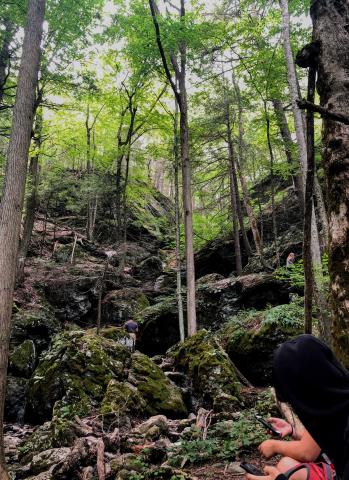
And that’s what the LEAP was actually about. By getting out of our comfort zones physically – on these trails deep in the woods with views that would knock your socks off, but also in Amherst more generally – we were able to get out of our comfort zones mentally and emotionally as well, and develop much deeper bonds with the other students in our groups than we would have from three days of “get out into nature” and other cliches.
Taking the LEAP introduced me to people who are still among my closest friends today; two are on the rugby team with me, including our group’s upperclassman leader, who told me about his own experience leaving a sport he had a lot of experience with, which gave me the confidence to take the leap from crew to rugby. One of my LEAP-mates and I, whenever we see each other around campus, will still do our group’s handshake, “slappy salmon,” which essentially involves frantically slapping your hand against your partner’s forearm while they do the same to you, resembling two wriggling fish; it draws a fair number of odd looks whenever we do it, but it’s a fun way to remember all the close moments we shared on the three-day LEAP and countless times since.
It’s hard to overstate how much your friends and peers at Amherst will contribute to your learning, your growth, and your happiness. The LEAP trip tosses you into a situation where not only you, but everyone else around you as well, is out of their comfort zone and looking for support, and you’ll learn to support each other. That sort of shared experience, and the relationships that develop from it, is why I think Amherst has so much to offer, and why it’s so rewarding to be a part of this community.
July 21, 2020
Amherst offers 40 majors. Among the Five Colleges, there are over 6,000 courses to choose from. You get to pick 32 before you graduate. How do you decide what you’re going to spend a single semester on, much less a major that will shape your entire college experience?
Well, your advisor will certainly help. Every new student is matched with a faculty member (generally in a field relating to your interests, if you indicated any on your application – but don’t sweat it if you didn’t) who will guide them through the process of course selection. Once you declare a major, you’ll be assigned (or you can choose) a faculty member within that department to guide you; if you have multiple majors, as I do, you’ll have an advisor for each one. Both before and after declaring your major(s), your advisor will help both with logistics, like figuring out how to use the registration system, as well as conceptually, regarding what departments and courses interest you and how to balance them all in your schedule.
But the process is always driven by the student. It’s on you to come up with six or eight courses you’re interested in for the upcoming semester; you bring these to your advisor when you meet. They’ll guide you, helping you make sure your workload is manageable and helping you figure out what you’re most interested in; they’ll also push you – out of your comfort zone (sometimes quite far out), into new subjects and departments that you may never have considered before.
If I can offer one piece of advice, it’s to make full use of the open curriculum. I can guarantee that at least once in your advising experience – probably in your first meeting, as well as in many thereafter – you’ll hear something like, “But have you considered taking a course in [department that you most definitely haven’t considered taking a course in]?”
I consider myself pretty flexible and open-minded, and usually try to go with my advisor’s advice on this: “Sure, I’ll take an American Studies course.” But even I have my limits: “Theater and Dance? I don’t know, that’s really just not my thing.” My advisor and I went back and forth on that particular suggestion for quite a while; eventually she won. I took the course and, needless to say, was way out of my comfort zone. But it was still an incredible experience. I got to meet people and make friends I wouldn’t have otherwise; I saw a completely new side of Amherst; really, I saw a completely new side of language, art, and the creative process.
Was it easy? Absolutely not. Was it worth it? Absolutely yes.
Take advantage of everything Amherst has to offer; I took my first computer science course just to see what all the hype was about, and now I’m majoring in it. I decided to double major because I’m equally excited about two very different fields; at Amherst you can make it happen, and now I have double the breadth of jobs and internships I’m qualified to apply to.
The process of exploration, more than any particular discipline or idea, is what it means to study the liberal arts. Amherst will fill up the tank and hand you the keys; it’s up to you to decide where you go.
July 14, 2020
Academics at Amherst are about much more than assignments or grades; Amherst is a place for learning, in all the forms it can take.
One common way students learn beyond sitting in classes or writing papers is by participating in research, either independently or in conjunction with a faculty member. About half of seniors write a thesis within their major, which is supported by a faculty advisor and the resources of the college, but at its core is created and driven by the student and their passion. Many students spend their summers working on research through programs like the Summer Undergraduate Research Fellowship (SURF), which is designed to give STEM students early research experience under the mentorship of faculty; other research, during the summer or the school year, is not part of a formal program like SURF, but arises from partnerships between students and faculty that occur more organically as a result of shared interests or skills.
My own experience with research this summer has been, like so many of my most valuable experiences at Amherst, an unexpected adventure.
My path to this project started last winter, when I decided to take a few of the brief, non-credit courses and workshops the college offers during the interterm break between fall and spring semesters. One of these courses was “Introduction to Geographic Information Systems (GIS);” I didn’t have any particular reason for taking this course, but it seemed like cool stuff. I learned the basics of the ArcGIS mapping and geographic analysis software and realized how much fun I had playing around with it. A couple months later, I got to hone these skills and apply them in a practical setting as part of a volunteer project I did with the Massachusetts public defenders’ office.
And then I got an email from the professor who had taught the Intro to GIS course over the interterm; he said a faculty member was looking for a student research assistant with GIS experience and asked if I was interested. I told him I was, and he put me in touch with Professor Debnam Guzman, an economics professor.
Professor Debnam Guzman introduced me to the project, a study on the effect of mood on college choice, and told me about what my task would be: to determine a measure of cloudiness for each zip code in the US, every day for a two-year span. In short, I would be a history and computer science major, working for an economics professor, researching meteorological data; interdisciplinary study is a pretty big thing at Amherst.
The task sounded simple enough – get information on clouds from all the weather stations in the US, use ArcGIS to plot it on a map, correlate with the zip codes, and boom. Simple, of course, until it came to actually doing it; there are 41,702 zip codes in the US, compared to only a couple hundred weather stations, and with very inconsistent reporting of cloud data across them at that. It soon became clear that this approach would not have nearly the amount or specificity of data required.
I looked around for potential alternative solutions and eventually found out about Google Earth Engine, a cloud computing service for large-scale analysis of geographic data; more importantly, it provides datasets which, with a bit of toying around, yielded the cloud cover information I needed.
The project has been an extraordinarily rewarding (and frequently even fun) problem-solving adventure. I’ve had to learn JavaScript which, for all my complaints about it as a programming language, is still a very useful skill to have. Professor Debnam Guzman has been a mentor and sounding board for my ideas, such as when the volume of data to analyze resulted in agonizingly slow runtimes, and I had the idea to randomly sample a set of points in each area so we didn’t have to process every single square kilometer in the US. She told me to run with it, and I’m now seeing significant progress on that front. I’ve learned the practice of keeping track of what decisions and judgement calls I make and the value of tenacity in surmounting obstacles.
I landed this project because I found something I was excited about and I ran with it; this is one of the most valuable things Amherst has taught me how to do in every aspect of my life. What’s more is that even though I’m not an economics major and in fact have never even taken an economics course, pursuing this passion beyond my comfort zone has yielded invaluable skills that have prepared me for future opportunities, which can now come from so much wider a field than they would have if I had remained confined to my own niche. That’s what research – and what Amherst – is all about.
July 7, 2020
If you had asked me when I committed to Amherst what I thought one of my favorite experiences would be, “rugby” would have been the farthest answer from my mind. My athletic background was in crew – I had rowed for six years before coming to Amherst, and arrived fully expecting to continue in that sport.
It was little more than pure luck that I ended up on the rugby team. At the club fair at the beginning of my first semester, a bunch of guys had essentially shouted at me until I came over to talk to them, then they convinced me to give them my email. Then they emailed me pretty much every day until I relented and showed up – completely unprepared – for one practice. At that practice I ran around for an hour and a half, having absolutely no clue what I was doing, but I ended up having so much fun that, on a whim, I decided to toss out my six years of experience with crew and join rugby at Amherst.
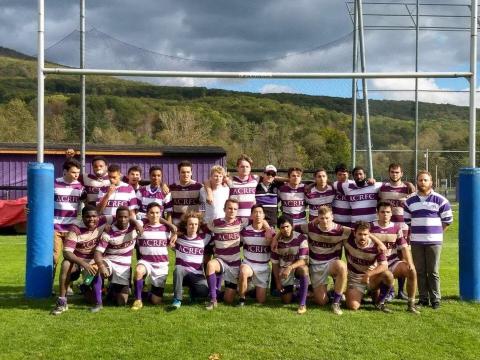
It was a steep learning curve. Our first game was less than two weeks after my first practice; I played for 60 minutes of the standard 80-minute match, with only two thoughts in my head: “don’t get a penalty” and “try not to die.” It turned out that those two thoughts were enough, as we were able to take the win that match, and we put up a pretty solid showing for the remainder of the season as well. But one of the most bitter defeats we had was against our rival, Williams College. Giving up the jerseys we bet on each rivalry match and learning that this was only the latest in a seven-season losing streak against Williams put a pretty big dent in my satisfaction with the season.
We entered the wintertime, when training is more self-driven and fitness-focused, with this rivalry defeat weighing heavily. Compounding the sheer number of consecutive losses was the fact that our then-captain, Patrick, who had been instrumental in rebuilding the team after it had nearly disappeared from lack of interest, would be graduating at the end of the spring; he had never won a Williams jersey. We all hit winter training looking ahead to our next – and Patrick’s final – match against Williams at the end of the spring.

The spring started with a 7s series, a smaller-team, faster-paced version of the traditional 15s rugby. Because you’re playing with half as many people per side, 7s requires each person to play every position, and it helped me develop more skill and insight into everything that goes on in a rugby match. But after the 7s series, our whole focus returned to preparing for our 15s match against Williams. We had hoped for a scrimmage with another school beforehand to get back into the rhythm of 15s, but it had to be cancelled because of weather; the big game would be our first, only, and truest test.
We ended our last practice with a pre-match Xavier, a tradition consisting of a lot of hollering, running around, and beating of chests to work up some adrenaline the evening before a game. The next morning at our team breakfast, the anticipation was palpable. We had done the workouts, we had practiced the plays, we had done everything we could; now it was time to execute.
Coach Hoffman was waiting for us on the field, and our opponents arrived as we started our warm-ups. The last match had been hard-fought on both sides, and no one expected any less from the trial to come. When the starting whistle blew, both teams charged at each other full speed and collided like a thunderclap.
We won possession and hammered and hammered away at their line until, all of a sudden, we were on the board; five minutes in and we had scored five points, converted to seven with a kick. We were as shocked as anyone else.
Then we scored again at ten minutes; five more points. It was suddenly a game far different from what anyone had expected.
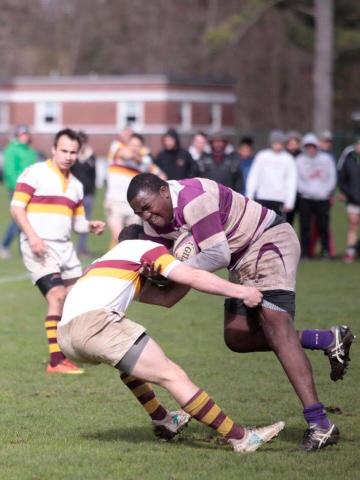
Those 80 minutes were among the most intense of my life; we hit them, they hit us, and we went back and forth for the entire match. One of the few moments I can remember clearly – the rest are blurred together by the adrenaline – was the instant I saw a gap in our line, and the Williams captain was about to get through it; he charged, I charged, and I took him down. After that hit, I couldn’t feel my shoulder for the rest of the day, but, man, that thud was still one of the most satisfying feelings I’ve experienced.
When our scrum half kicked the ball out to end the match and the referee blew the final whistle, our sideline – usually small, but in this particular event augmented by alumni back to watch the rivalry match and spectators from a soccer game that had just wrapped up who had taken an interest in our match – exploded. A rugby alum who at the time was also my supervisor as a tour guide gave me a bear hug. Coach Hoffman rushed the field with one of his kids in each arm, yelling like a lunatic. We had won in spectacular fashion; snapping a Williams win streak, at home, in a 24-0 shutout. And Patrick got the Williams jersey he so deserved, weeks before graduating.
I could go on about rugby for days. I could talk about our undefeated regular season that became a dark-horse run to the finals last fall, ending in a second-place finish no one could have predicted; I could talk about how serving on the team’s executive board has helped me grow as a person and as a leader; I could talk about how my rugby family has helped me through some of the most difficult times in my life, academically and personally. Every single person on the team – Patrick, Coach Hoffman, and countless others – has been a mentor and a friend. Both my Amherst experience and my life would be so much the lesser without these fine people as part of them. And to think it all happened on a whim just goes to show the irreplicable, irreplaceable magic of random chances that can fall into your lap at Amherst.
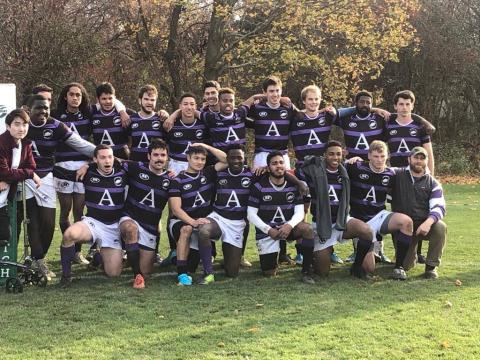
ACRFC after the championship finals in fall 2019.
June 23, 2020
NOTE: This is the second of a two-part blog post about professors at Amherst. Part I covered the more concrete aspects of professors’ contributions to the Amherst community through their research and teaching. This post talks about how professors support students in other aspects of life, and how professors handled the transition to remote learning in Spring 2020.
Beyond the classroom, Amherst professors continue their engagement with and support of students. All professors hold regular office hours several times a week, where students can drop in to ask questions, get help, or just chat with their professors. In my first year, I was hesitant to make use of office hours; I didn’t want to seem like the new kid who didn’t know what they were doing and needed extra help to succeed. But since I got over this fear, I’ve realized that it was an unfounded one to begin with. Now I regularly use office hours for help when I need it, but also to get to know my professors better as people, or even just to do work on my own in a space dedicated to that subject. Developing this rapport with your professors can help you get so much more out of your courses, and can connect you with internships and professional opportunities throughout and beyond your college experience.
Of course, this experience changed dramatically halfway through this past spring semester. Because of the COVID-19 pandemic, we were told mid-March that almost all of us would have to head home indefinitely, which turned out to mean the rest of the semester. Naturally, there was a lot of emotion, confusion, fear, and a fair bit of straight-up chaos over the next two weeks as we transitioned to remote learning. But throughout the process, and over the remainder of the semester, Amherst professors went above and beyond on behalf of their students. In the first few days after we were told we’d have to leave, one of my professors told us, and asked us to tell our friends, that he had storage space in his garage if anyone needed to leave things behind; another completely cancelled an assignment we had due and dedicated our last in-person class session to simply be a space where people could share, vent, cry, or do whatever they needed to do to process the news.
Once everyone had returned home and it was time to resume classes, professors were proactive in trying new and unfamiliar things, repeatedly gathering feedback from us, and putting immense amounts of their own time and effort into making the remote learning experience as productive – and as stress-free – as they could. Many even turned remote learning into an opportunity to do things otherwise impossible in a traditional classroom setting; for example, my history professor had a relevant expert join one of our classes from Afghanistan, adding a perspective we would not otherwise have been able to learn from. This sort of support extended beyond academics as well; my math professor hosted weekly “social office hours” where students could hang out, chat, and connect with one another despite our physical distance, all to the tunes of playlists my professor had curated for these sessions. All of these initiatives – and, more importantly, the profound sense that every professor was really trying to do their best for their students – turned a derailed semester into a meaningful and productive (if unplanned) experience.
Hopefully this two-part post will have given a bit more clarity to the question of “what’s the deal with professors?” Amherst could never be all that it is without the contributions our faculty make to the student experience both inside and outside the classroom.
Please keep checking back on this blog to learn more about life at Amherst! As always, please reach out to me at drao22@amherst.edu with any questions or thoughts about these posts, Amherst in general, or the college experience as a whole.
June 16, 2020
NOTE: This is the first of a two-part blog post about professors at Amherst. There’s so much to say that I decided to dedicate this first part to the more concrete aspects of what professors do and how they teach at Amherst. Part II will cover the more abstract, but just-as-important topic of how professors support students beyond the classroom, as whole individuals, including how faculty handled the turmoil of the transition to remote learning in Spring 2020.
Professors can make or break an education. Amherst is no different, and while professors here certainly fall into the “make” category, their contributions extend so much further that academics. Amherst professors are insightful experts, dedicated teachers, and genuine guides through the Amherst experience.
On one of the first tours I ever gave at Amherst, a student sheepishly asked me “So, uh… what’s the deal with professors?” This question stuck with me because when I was applying to college, I didn’t know anything about what professors were like as teachers, as mentors, or even really just as people. But I think our faculty are one of the best parts of Amherst; they deserve a proper introduction to our prospective students, and hopefully readers of this blog can walk away feeling like they know a little more about what the deal with professors really is.
All professors at Amherst conduct their own original work in their fields, from the arts to the humanities to the hard sciences. This gives them unique insights into the subjects they teach, and because all courses are always taught by professors instead of teaching assistants, we as students benefit from these insights as well. Students actually get to participate in this work too – at an undergraduate-only institution, we don’t have to compete with graduate students, who already have a degree in the field, for research opportunities; from the moment you step on campus, there are plenty of opportunities to get hands-on involvement in any field you’re interested in.
This summer, in addition to my work blogging and giving tours, I’m also working as a research assistant for an economics professor. I had never met this professor before this opportunity (in fact, I’ve never even taken an economics course), but because I have experience with geographic information systems that she needed, I was able to join her work. In short, I’m a history and computer science major, working for an economics professor, doing geography and meteorology research. Interdisciplinarity is a big thing around here, and it just goes to show how much there is to do and learn at Amherst if you’re willing to put yourself out there.
As much as Amherst professors are engaged in and excited about their research, teaching is their true passion. They came to Amherst because they wanted to be in a small classroom setting interacting with Amherst students and our ideas. Very rarely is a class session (much less an entire course) primarily in a lecture-based style; it is almost always a discussion between the professor and the students, as well as among the students. Because of the open curriculum, no student ever has to take a course they don’t want to, and no professor ever has to teach a course they don’t want to either; everyone in each of your classes is there because they’re excited about the material and excited to discuss it with others, making for an energetic and dynamic classroom environment.
Overall, faculty at Amherst provide a unique and rich learning experience for students. From their piercing insights into the subject matter to their dedication to fostering a thorough understanding and enduring curiosity among their students, Amherst professors provide an education second to none. Amherst wouldn’t be the same without them.
Be sure to check out Part II to learn more about everything professors do outside the classroom as well! In the meantime, please reach out to me at drao22@amherst.edu with any questions about faculty, Amherst in general, or the college application process more broadly.